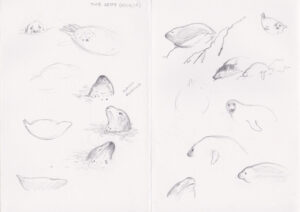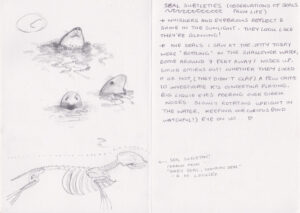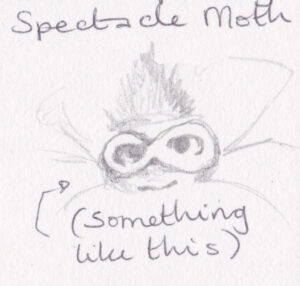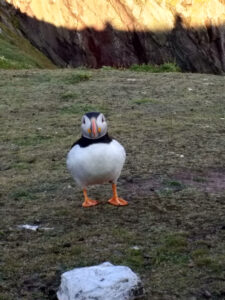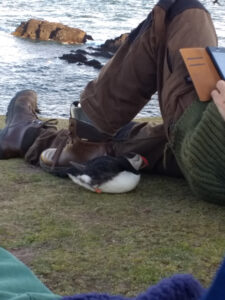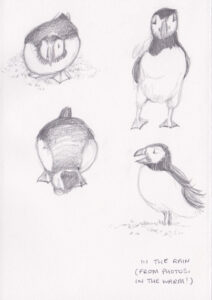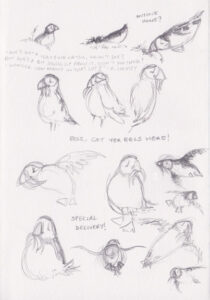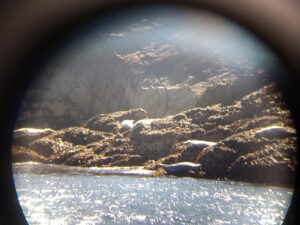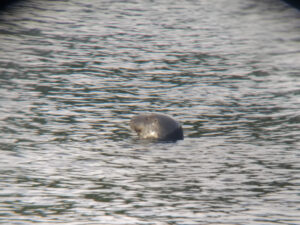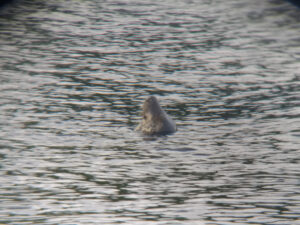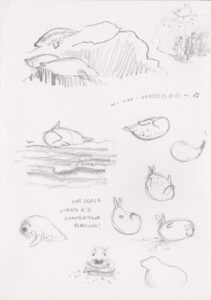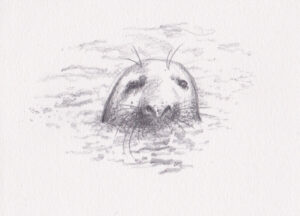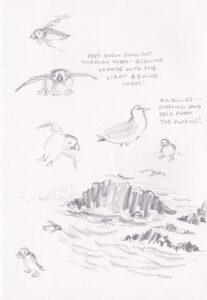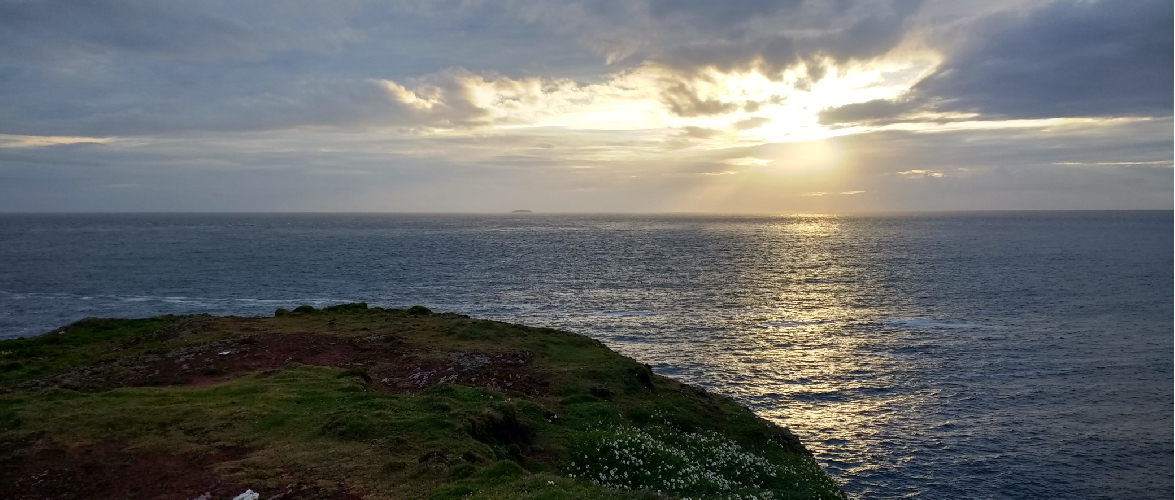
“We must leave this province of the laboratory and theology to resume our study in the field.” Ronald Lockley, “The Island”.
Third time’s a charm, or so they say. After two failed attempts to leave Martin’s Haven jetty since 2017, I held my breath, and crossed every part of my body that could be crossed in hope that this little superstition might hold firm this time.
Fair winds and a spot of good fortune later, and I can joyfully proclaim that WE MADE IT TO SKOKHOLM!!
While we (my partner, his parents and I) were there, I kept a journal- a diary and study of every wonderful thing I learnt during a week on the island, as I made friends with as many of the inhabitants as I could! This sketchbook accompanied me in all weathers and crossed a small portion of the Celtic Sea twice- it’s far from polished, but I think that adds to its charm- a bit like an old fashioned explorer’s log!
In honour of the wildly wonderful island community of Skokholm, let me tell you the story of a week spent among puffins, seals and stiff salt breezes with the help of my little battered book!
(All photos and sketches: © 2019 Carina Roberts Illustration, unless credited otherwise.)
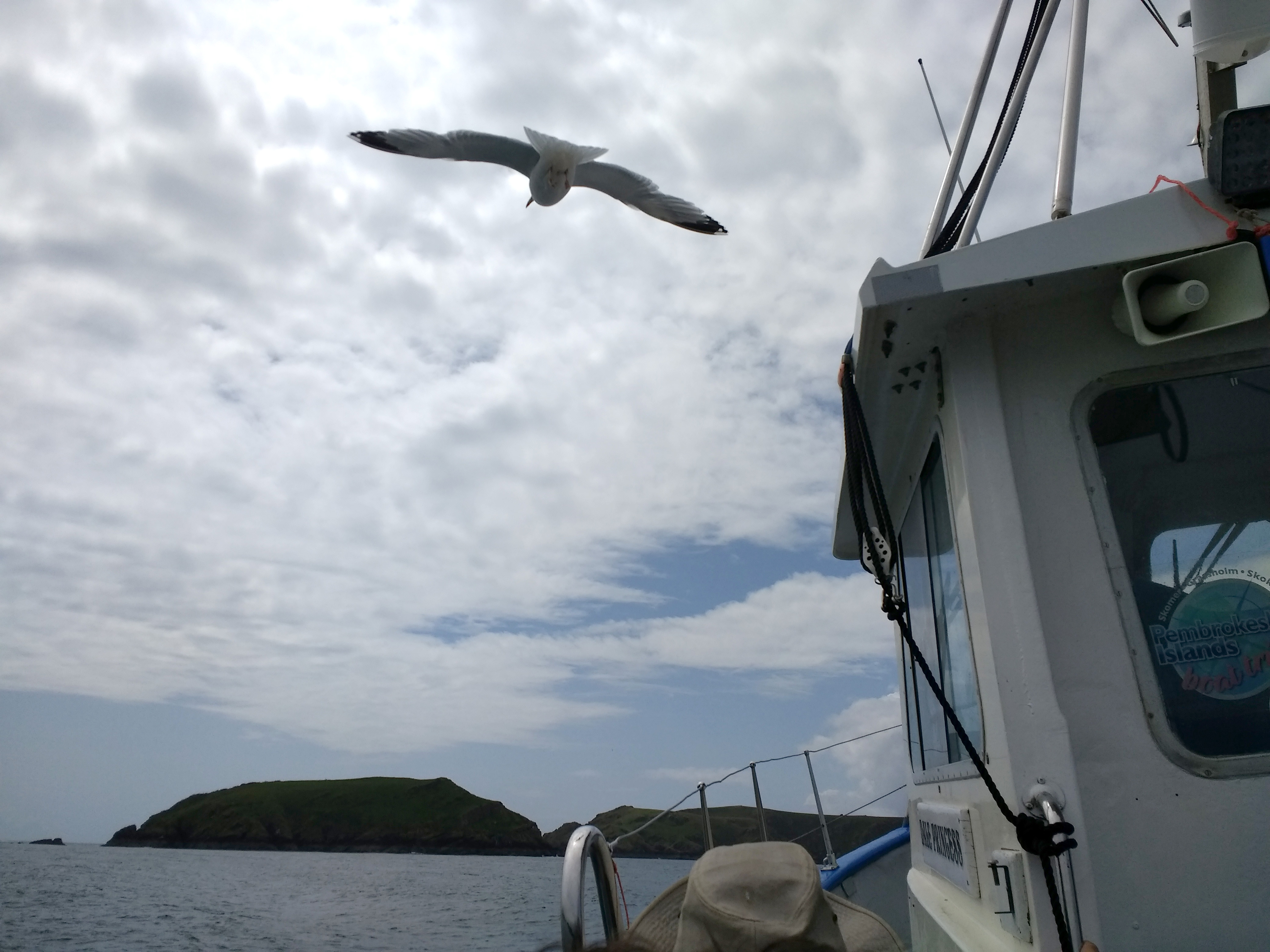
Day One – Arrival
From home to Pembrokeshire, through Marloes and on to Martin’s Haven, 03/06/19. Passing luggage onto the boat through a chain of all the people you’re going to be sharing your home with for the next week is a great way to get to know them! (Wonderfully reminiscent of my summers spent camping with Guides, too!) Departed around 1:30PM on a slight swell, around 20 of us altogether- not choppy, but a little touch and go for the seasick among us (for once, not me!) It didn’t take long to spot the first locals- we were joined for most of the crossing by a gull gliding over our heads, and the tiniest flash of bright red, yellow and brown-black whizzing over the water would be my very first puffin sighting! And who would be waiting in the South Haven harbour for us but a speckled group of seals, wiggling about in the afternoon sunshine- with others popping their noses out of the water to see who had arrived today. What a welcome!
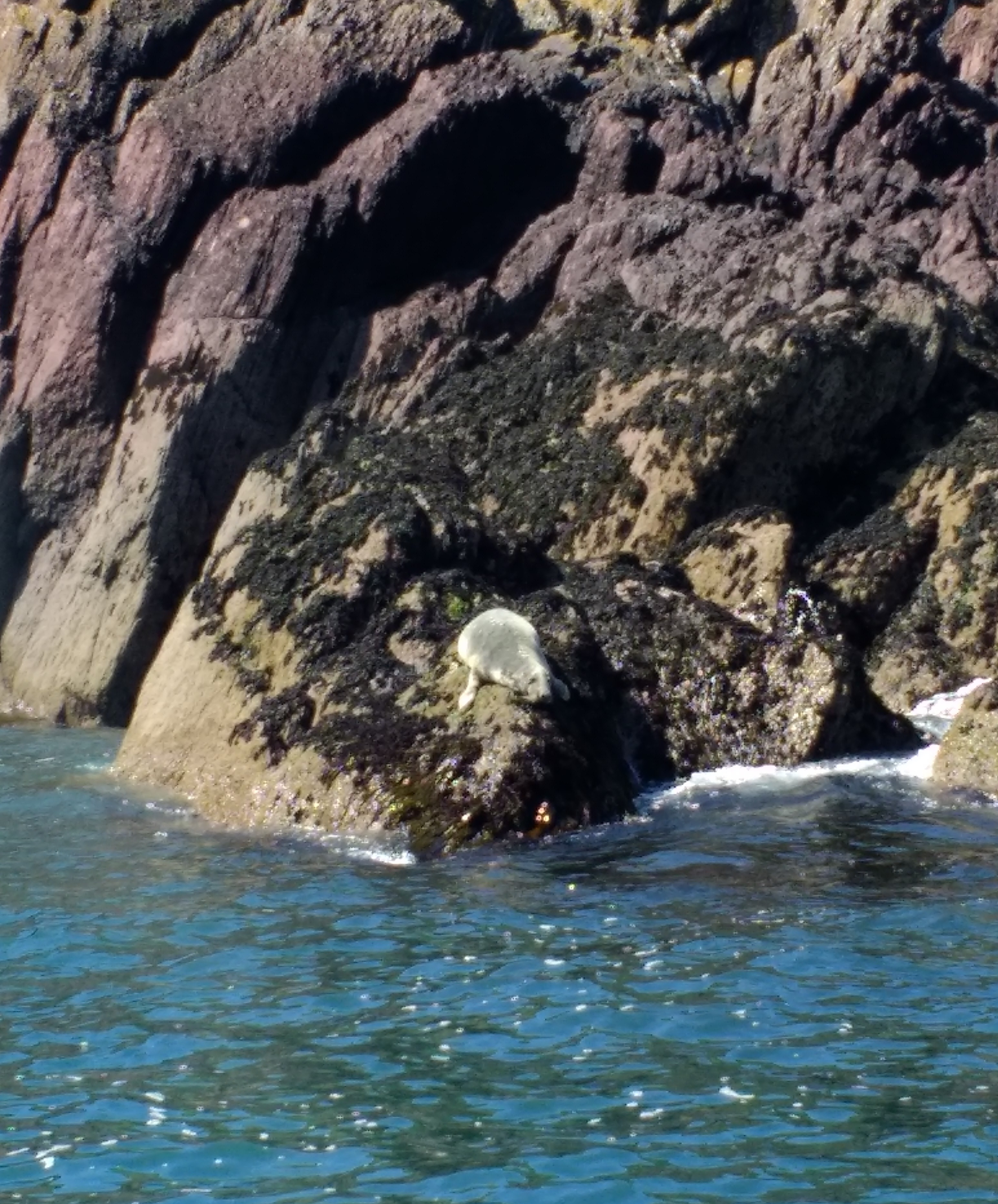
Continuing the warm greeting, we all joined Richard the warden for a cup of tea and an introduction. Skokholm is home to thousands and thousands of seabirds every spring and summer, (including over 9,000 puffins!) as well as the aforementioned seals, butterflies, moths, and lots of other types of birds. As a Special Protection Area, a hugely important National Nature Reserve and a Bird Observatory, humans are very much in the minority- the island belongs to the feathered and furred inhabitants. Pathways are set up with white stones to show visitors where they’re allowed to walk around the island- keeping a respectful distance away from the residents (although you sometimes have to be careful not to tread on any burrows!)
Exploring on this first day, we visited Howard’s Bay and Crab Bay, the latter being the best place on the island to see puffins- not only are there a lot of burrows, this is where the puffins are tamest and the most inquisitive! As Richard told us later on at the Bird Log that night (where the two wardens, volunteers and guests can gather to give their wildlife sightings of the day) if you keep still enough they will come up to investigate, and perhaps even sit on you!
Settling into our room that night, blankets up my neck, I was surrounded by an ornithological racket- idyllic when mixed with the sounds of the lapping sea and whistling wind, but not exactly quiet! I stayed up pretty late just listening to the wild world outside… What a wonderful place!
Day Two: The drawing begins!
Day Two (04/06/19) was wet, so after a little more exploring we visited the hide (and the puffins!) at The Neck, overlooking North Bay. This became my workplace for the day, as I watched the puffins congregating, chattering, and generally being busy. I stayed until my fingers were too cold to draw anymore – click on the sketchpages below to enlarge today’s findings!
(Click on any of the images to see larger! © 2019 Carina Roberts Illustration)
A bit of expansion for the little notes made here:
- The puffin’s folded wings seem to cross over when viewed from the back, with a beautiful arrow pattern picked out in white across the dark brown-black.
- As in the colour gouache studies, rain droplets beaded on the feathers of the landed birds- I know it’s not surprising as they spend so much time in and around water that they would have impressive waterproof jackets, but it was amazing to watch it happening in slow motion!
- There were some pretty fabulous “boy band” power stances going on there!
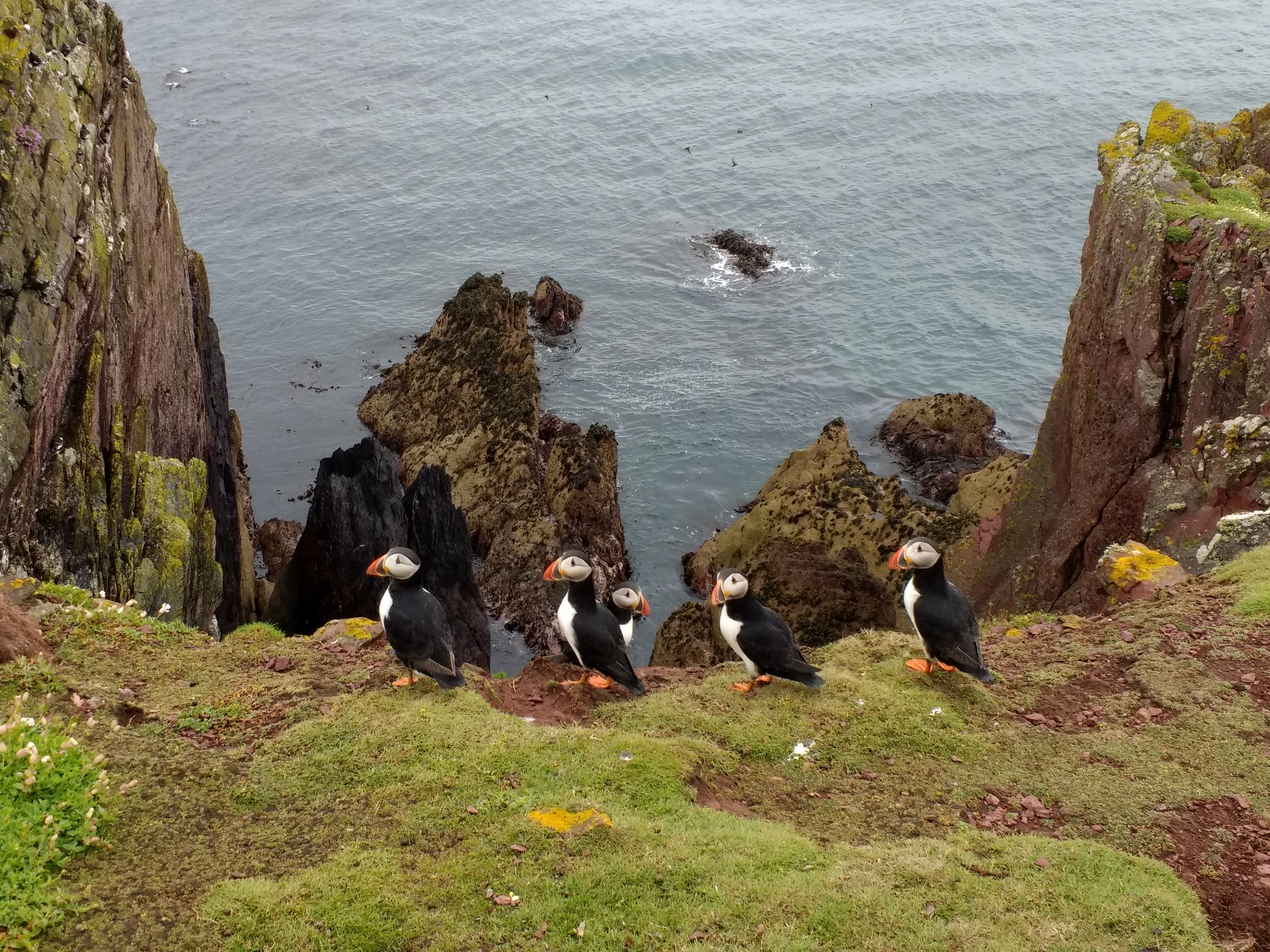
- Puffins (or other seabirds for that matter) “raft” – float on the sea in large groups, particularly early in the season, so I’m told.
- I discovered two new plants that day- rock sea spurrey (sperularia rupicola), and sea campion- a halophyte, a plant tolerant to salty soil.
Day Three- An Introduction, The Jetty and the Seal Chorus!
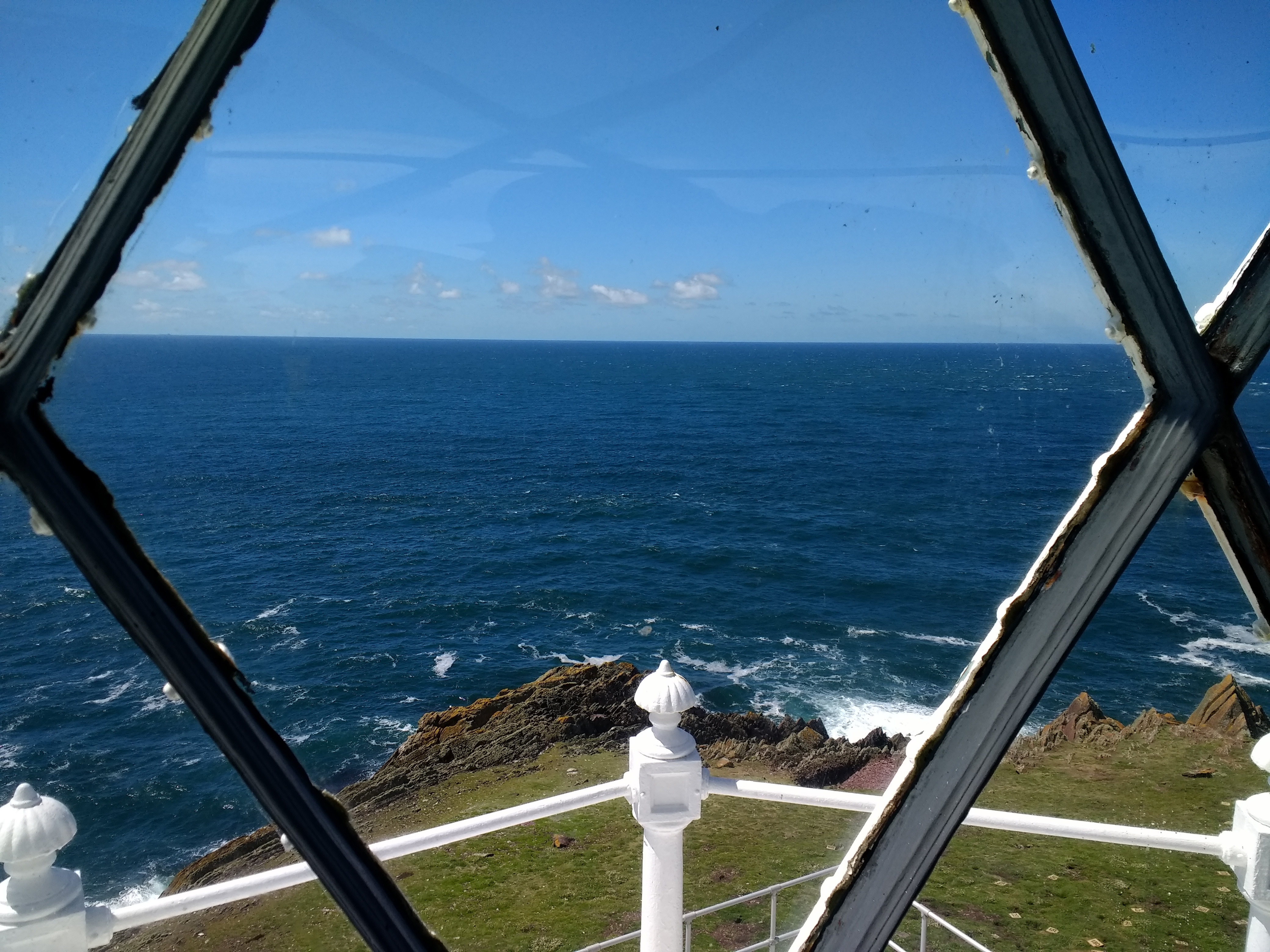
The third day brought a strong breeze and brilliant sunshine, so we were led out on our postponed introductory walk by Richard the warden. We got acquainted with the main flora and fauna to be found on the island, as well some of the key locations around the perimeter- including a quick tour around the lighthouse.
Looking out from the disused lantern room over Grassholm and the wild ocean, we were told a famous ghost story. Just visible on the horizon through the telescope was the Small’s, another lighthouse which used to work together with others along the Pembrokeshire coastline to protect ships.
The tale goes that two lighthouse keepers were put in charge of the Small’s who didn’t get on, and would constantly quarrel. When one of them died, the other was terrified that he would be accused of murder, so he made a coffin and hung it from the lighthouse, hoping to be exonerated. Records show that passing sailors noticed the coffin, but no-one came to question it – or take the body away…
The coffin broke open during a bad storm, and the sound of the body slapping against the window of the hut eventually sent the remaining keeper mad. The poor man lived out the rest of his days in an asylum.
Some more (slightly more jolly!) things I learned:
- A lot of the plants around the island are typically found in woodland (wood sage, sorrel, red campion) – apparently it should be covered in trees, so the Norse word “Skokholm” (“wooded island”) would suggest. I wonder why it isn’t? Perhaps these days it’s more exposed to strong winds, as a lot of the plants and shrubs which grow are fairly squat to the ground?
- Scarlet Pimpernel (Anagallis arvensis) flowers were particularly interesting to Darwin- apparently when cross-bred with the blue variety would produce a purple hybrid!
- The Quarry houses the “Petrel Station” nestled in amongst the towering cliffs – a man-made wall with boxed burrows in the back which the volunteers and wardens use to monitor the Storm Petrels. (More about that on Day Four!)
- Manx Shearwaters dig their own burrows, and the chicks are beautiful bundles of brown fluff which are weighed every week or so to monitor their progress. The burrows are marked with numbered boards so they aren’t stepped on, and the birds themselves are fairly used to being handled by the wardens and volunteers. Richard scooped one out to show us, they were a lot smaller than I expected! (Sadly they are a favourite food of the great black-backed gulls, so it’s very common to see their carcasses dropped around.)
Still fair weather in the afternoon, so at low tide I wandered down to South Haven jetty where we had seen the welcoming party of seals two days ago with my partner and his mum, in the hope of seeing some more.
We managed to spot twenty-one of them around the bay! Some were snoozing stretched out on rocks, others cruising about and “bottling” in the warm shallows- resting vertically in the water, huffing through flared nostrils. A couple in particular came so close to the jetty where we sat, curiously winking at us with those huge, liquid eyes of theirs. They definitely seemed to be interested in E’s mum’s concertina practice! The closest one slowly dozed off upright, a content grin seeming to spread from ear to ear.
(Click the images below to see my seal observations from life!)
Sketches © 2019 Carina Roberts Illustration
Day Four- Moths, Singing Seals and Storm Petrels by Night
This morning we were treated to the opening of a moth trap! Ishbel (one of the long-term volunteers) gently introduced us to each new beastie, sharing her extensive knowledge – we were all particularly excited to meet the Spectacle moth, as it has a really cute little face! (It’s also the only moth I’ve ever seen with a mini mohican! See sketch below)
After exploring Spy Rock and a couple of the bird hides in the morning, I went back down to the jetty in South Haven to draw my sealy friends again. I was joined by three other ladies who were staying on the island at the same time, and we had lots more willing models!
This afternoon was particularly exciting because the seals were chorusing together, wailing and howling a beautiful song that echoed all around the cliffs. I’ve never heard anything like it- now I understand where a lot of the folk tales about sirens must have come from!
Click on the image below to see more ‘morlo’ drawings- seal in Welsh!
(Sketches © 2019 Carina Roberts Illustration)
(A note here about a small sketch in the bottom-right corner of the page entitled “Figurehead of the Alice Williams” – in South Haven this figurehead replica watches over the harbour since the original was moved inside. The wreck of the same name was found and bought by R.M. Lockley in 1928, the timbers of which were used to help build the Wheelhouse- where the original figurehead now watches over the guests’ mealtimes.)
We were accosted by puffins for a short time at Crab Bay before dinner:
When it was dark, we all trooped along to the Petrel Station to see some of the Storm Petrels using Richard’s infrared camera. Even without the light, you could feel them flitting past your shoulders like bats!
A bit about these funny little birds:
- Storm Petrels are Britain’s smallest sea-bird, they’re only about the size of a sparrow!
- They used to be known as “Mother Carey’s chickens” to seafarers as harbingers of rough, stormy weather- Mother Carey being an ancient witch and the wife of Davey Jones- and were meant to embody the souls of drowned sailors.
- They only lay one egg, which once hatched is the father’s responsibility- he will float out to sea with the chick as soon as is possible!
- “Petrel” apparently came from the story of St. Peter, who could walk on water- they’re very light, and wouldn’t come inland unless they had to!
To conclude a birdy evening, we stopped on the walk back to our rooms after hearing a scuffling in the bracken just off the path- and spotted a Manx Shearwater hauling itself along on its belly through the undergrowth. (They’re pretty useless on land down to how far back their legs are on their bodies, so they’re nocturnal to reduce the chances of being eaten by gulls.) Soon, the air was full of them flying about on their nightly business, whizzing about and trying not to crash into each other- their banshee-like screeches much more eerie up close than from the comfort of bed!
Day Five- Lashing rain and howling winds
We were hit by a storm on the Friday, which meant a little sketching from life during the breaks in the rain but ultimately a day to explore the library and congregate in the cottage with the other guests to keep warm. (It was too cold even for the bird hides, really!) We did attempt a walk to the hide at North Bay, but spent most of it horizontal!
It was lovely to spend some time with the other people who were staying and get to know them, as well as the volunteers who popped in during the worst of it.
Our fifth Bird Log was a really good one- I learned that melanin, the same substance that colours our skin and freckles, is also what makes bird feathers healthy. The darker the feathers, the more attractive the male bird is to the female in the mating season- apparently a Coal Tit with his “bib” extended with marker pen was shown to get more females! Periods of feeding stress will result in “fault bars”- lighter lines in the feathers which are weaker and more likely to snap.
Click on the images below to see today’s puffin observations and studies!
Sketches © 2019 Carina Roberts Illustration
Day Six- An eely good one!
We went for a walk around the cliffs and past North Pond this morning- sadly the Shelduck parents have lost three of their chicks to gulls attacks. One of the other guests saw one actually get taken, which was a bit upsetting…
We ended up at Crab Bay where I spent the majority of the morning observing puffins bringing in the morning’s catch.
Click on images below to see the busy little birds hard at work!
Sketches © 2019 Carina Roberts Illustration
Our penultimate day, and I wanted to soak up as much time with the seals at South Haven as I could. At low tide I wandered back down to the jetty, and found plenty out sunning their speckles. As well as sketching, I experimented with taking some photos through my trusty binoculars this time- lining up my phone camera with one of the holes at the right zoom level so as not to be blurry took a bit of practice, but I did manage to get a few decent ones! All in the name of reference material!
Click below sketchpages to see seal observations larger.
© 2019 Carina Roberts Illustration
After dinner, E, his parents and I all wandered back down to Crab Bay to visit the puffins once more. They were very inquisitive this particular evening, one came up to investigate and peck at my bag straps, another came within two feet of me and gazed at me curiously for a few seconds, “And who are you, then?”
Then it happened- probably the crowning moment of the entire trip. A PUFFIN SIDLED UP AND SAT ON MY LEG! It wandered around me for a little while, and without warning hopped up and settled on my calf! I was surprised for such a little bird how heavy it was perching there (and I couldn’t help but wonder if I was going to be used as a toilet… luckily not!)
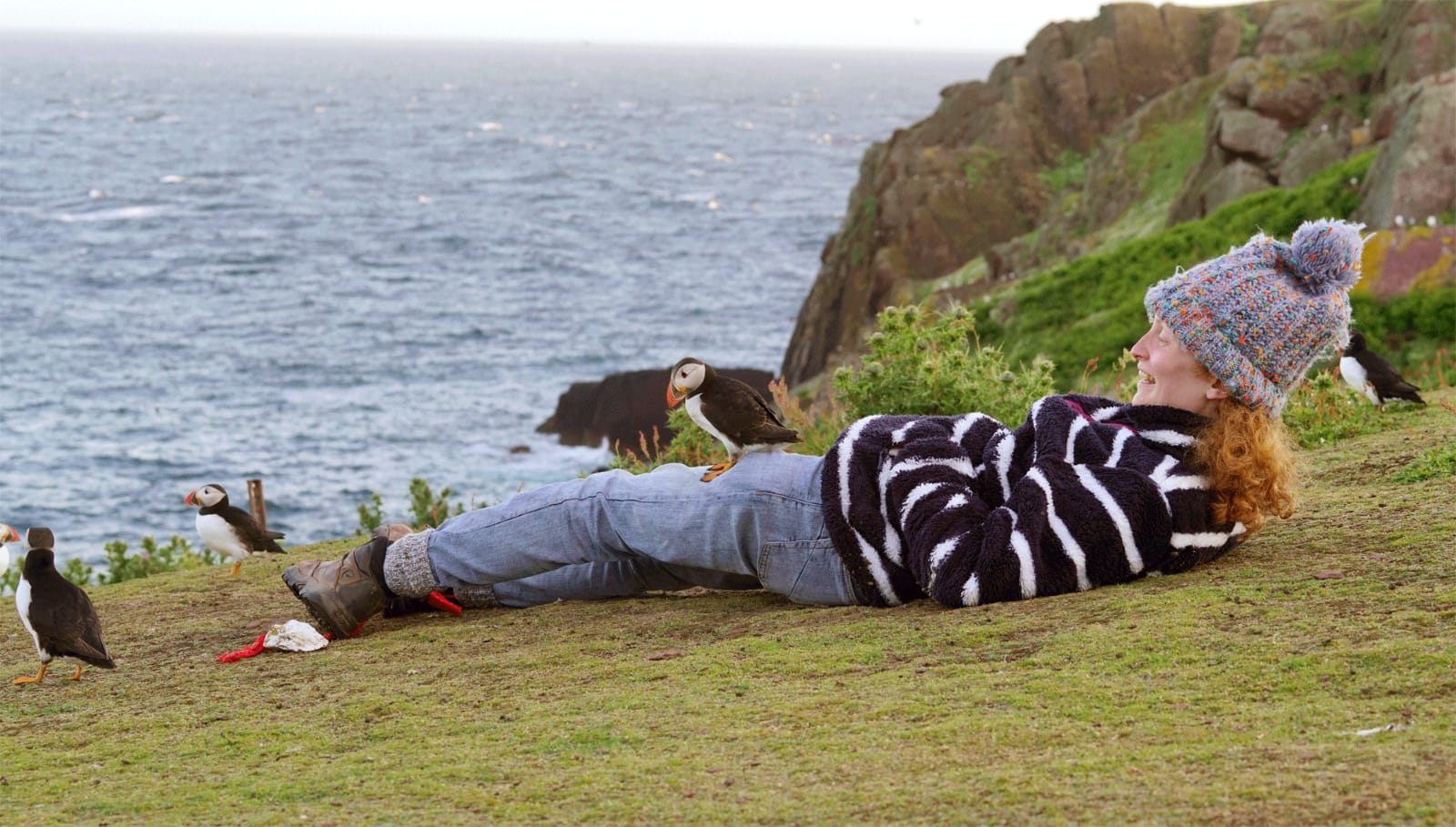
From this distance I could see every feather, every line, and every speckle on the red lid of the puffin’s eye (part of the “summer coat” which blooms with colour during the mating season and fades during the winter’s travels.) Being that close to a wild animal was indescribable… to practically be able to hear its heartbeat next to your own makes everything else slow down, and as you look the creature in the eye it’s like you give each other the little nod- “This great big rock that we’re sharing is pretty incredible, isn’t it?”
As the sun began to set, as if by magic, the puffins all seemed to shuffle rapidly away from us with the same urgency as if they were late for a meeting. They gathered in small groups, rubbing their beaks together (billing), head-bobbing and making little grunting sounds not unlike hiccups! One turned half towards me away from his little gathering, giving me a sideways glance which gave me the distinct impression I was being talked about!
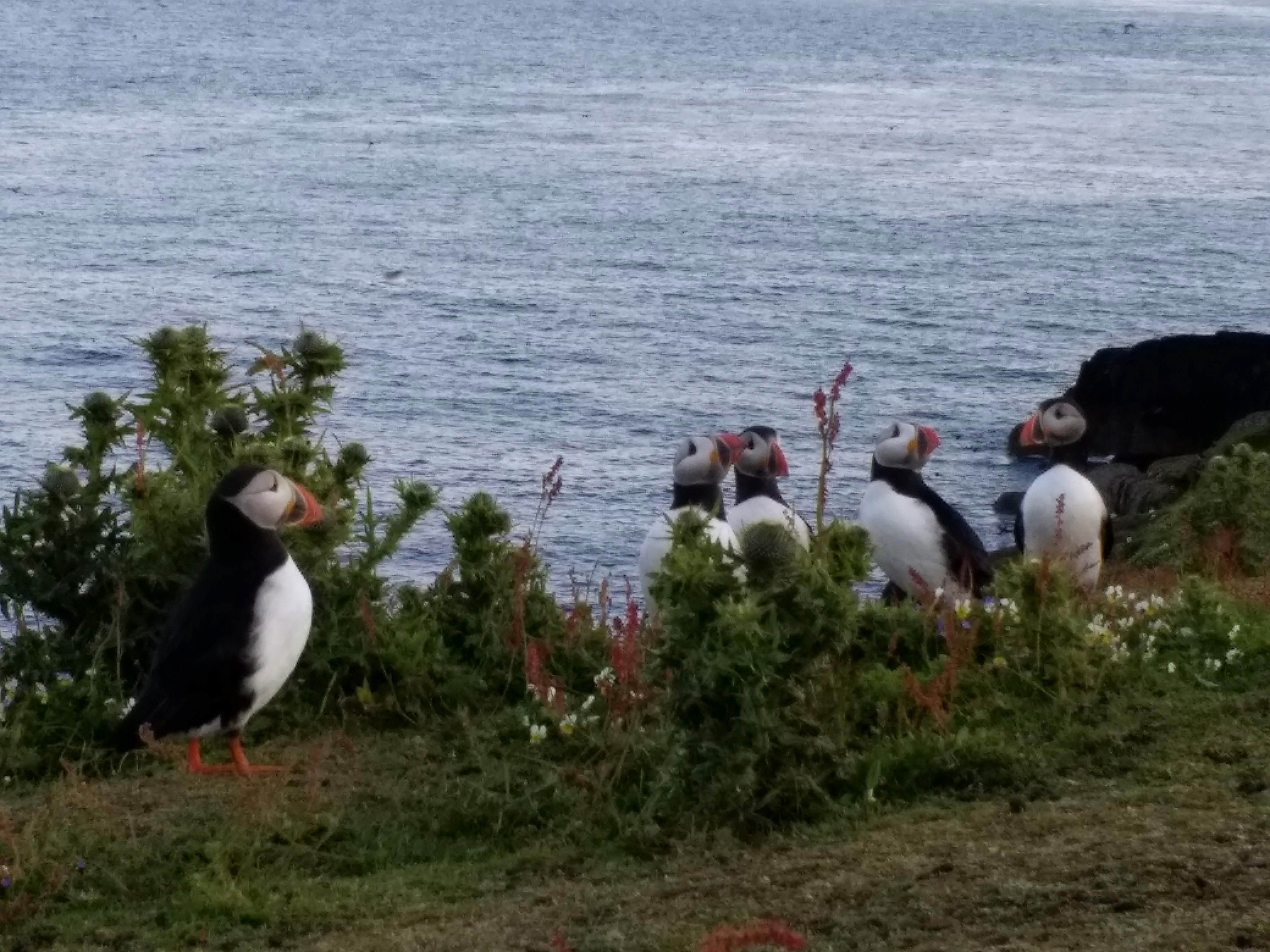
I wonder if the animals of Skokholm hold their own “Human Log” to discuss the people they’ve seen that day?
Day Seven- The last sunrise on Spy Rock

We wanted to make the most of our last day, so we hauled ourselves out of bed at 4:30AM to climb Spy Rock! From this point we could see the sun rise over the whole island, lighting up each tiny flower with a fiery glow all the way out to sea.
After watching another moth trap being opened (another spectacle moth was hiding inside!) we explored some of the nooks and crannies we hadn’t covered in our daily walks around the cliffs. After bothering the slow worms under the corrugated iron sheeting outside the red shed (we found eleven!) we popped into some of the remaining hides we hadn’t visited yet.
We watched a scrap unfold from the hide at South Haven as two seals had a slapping match over a particularly comfortable rock… The first and more aggressive of the seals wouldn’t share the space, and was very angry when a wave knocked him into the water! The second seal who had been trying to sneak on when the first wasn’t looking quickly jumped aboard, giving his rival a taste of his own medicine as they batted at each other with their flippers.
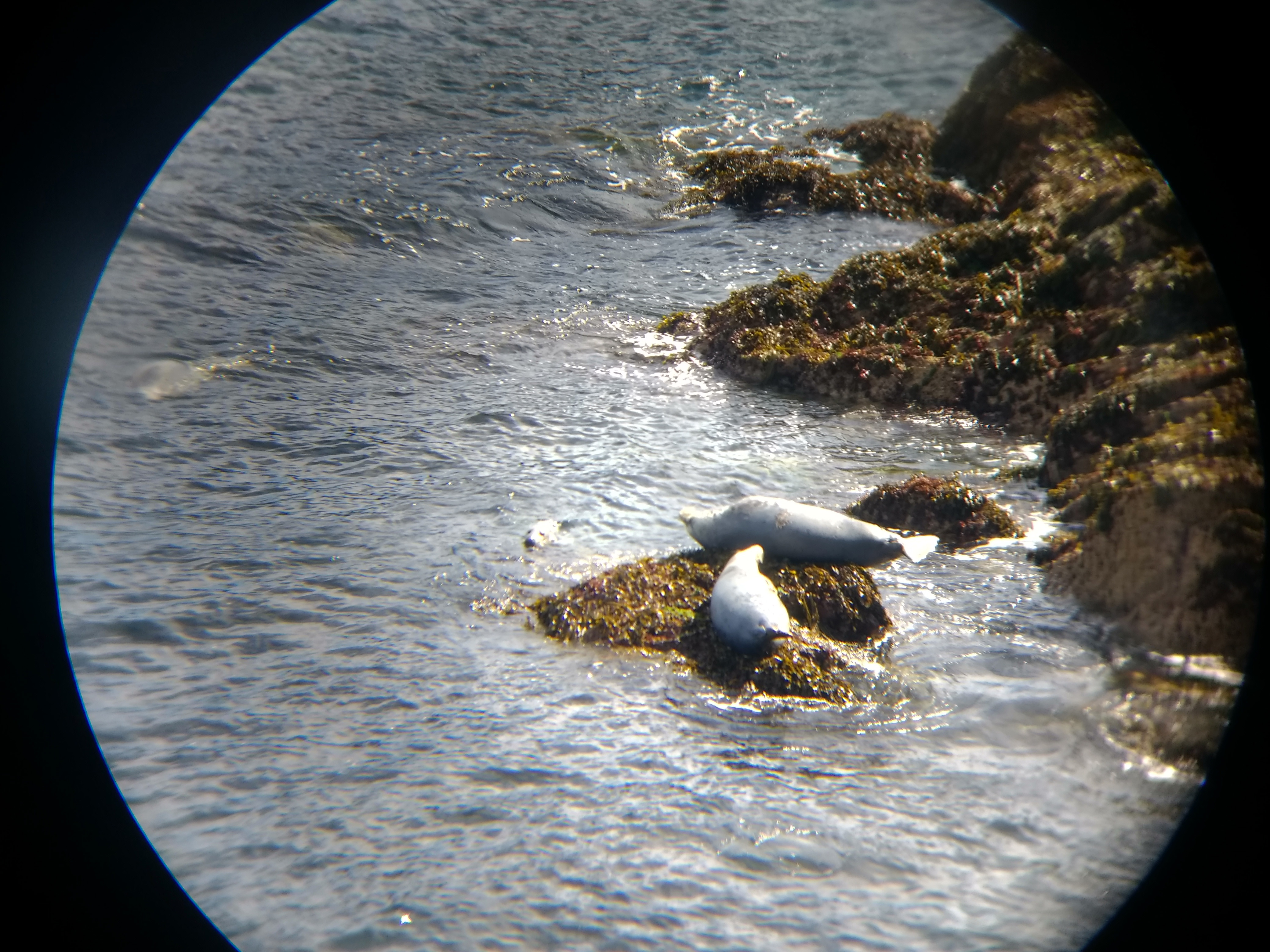
A scramble up and down the “hairy” walk around Frank’s point revealed the great black-backed gull food waste disposal – we found a pile of Shearwater carcasses all hidden behind a boulder, wings still intact. Definitely deserving of their nickname, “The lions of Skokholm” – I’m just glad I’m too big to carry off and eat!
As evening approached, I made two last visits to Crab Bay and South Haven to begin saying goodbye to all my new friends, with varying reactions. The puffins inspected my clothes, one hopping up onto my leg, another pecked my bum! I loudly proclaimed my love for the seals down at South Haven which was met by a resounding “WoOooOOO!” call from one…
Click below to see observations from Crab Bay and South Haven hides larger!
Fair winds homeward-bound
It was difficult to say goodbye on the last morning. As we waited in the harbour for the boat to take us back to mainland, the seals gathered as if to see us off- and as a little drizzle came down we all looked a little speckly!
We were lucky to have a particularly smooth crossing, but I couldn’t help shedding a few tears as I watched the island fade away into the distance. The opportunity to be outside from sunrise til sundown, with a wonderful little community made me increasingly sad as we returned to ‘civilisation’. So much feels like it’s missing from modern life in our quest for improvement and perfection- we isolate ourselves from the world, each other and even ourselves, and what even for?
As I begun this diary as a way to learn more about life on a very special island, so it continues- I’m in the process of using my first-hand experience to begin a new project about puffins, to add to my portfolio along with the short poem-story I produced for North Somerset Arts Week called “Seal Song” (more on that next time!)
So this week in Skokholm continues to remind me, as Tolkien said-
“It is brought home to me; it is no bad thing to celebrate a simple life.”
From my own reference drawings and photos- some preliminary gouache and pencil studies ready for this impending puffin project! Click to see larger.
(If any of you come across this- a huge thank you to the wardens Richard and Giselle, the volunteers Jenni and Ishbel, and all of my fellow guests for such a wonderful, special week!)
—————————————————————————————————————————————–
The AutumnHobbit
© Carina Roberts and AutumnHobbit. Unauthorized use and/or duplication of this material without express and written permission from this blog’s author and/or owner is strictly prohibited. Excerpts and links may be used, provided that full and clear credit is given to Carina Roberts and AutumnHobbit with appropriate and specific direction to the original content.



